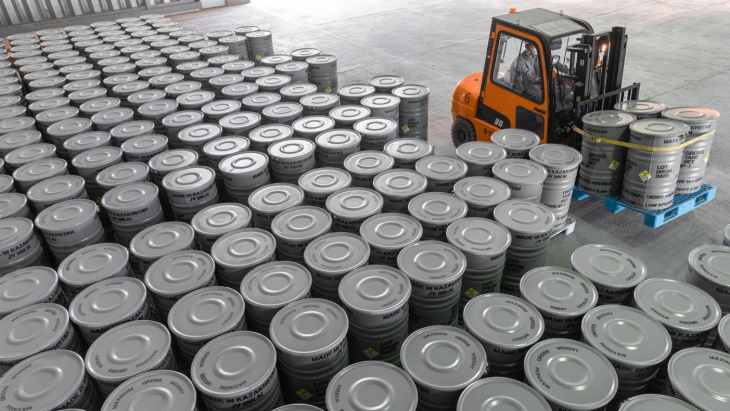https://www.world-nuclear-news.org/Arti ... ns-as-acidKazatomprom confirms 2024 production plans as acid woes continue
01 February 2024
The Kazakh national atomic company said it expects to see a "modest" growth in 2024 production despite adjustments to its previously announced production plans related to the availability of sulphuric acid and construction delays at newly developed deposits.
Image: Kazatomprom
Kazatomprom's 2023 production was 21,112 tU on a 100% basis (11,169 tU attributable), which the company said was slightly lower than 2022 production "primarily due to an insignificant decrease in the production plan for 2023, compared to 2022". 2024 uranium production volumes are expected to be 21,000-22,500 tU on a 100% basis (10,900-11,900 tU attributable), it said in its quarterly operations and trading update. For the majority of its mining operations, it expects that production volumes will be about 20% below the amount stipulated in subsoil use agreements.
The company had previously - in August 2022 - said it planned to increase its 2024 uranium production to a 90% level relative to its subsoil use agreements, which would have been the highest production against subsoil agreements since the company's 2017 decision to flex down production in response to supply and demand considerations. But in January this year, Kazatomprom said it expected to adjust the volume because of the challenges it is now facing.
Sulphuric acid is a key reagent in Kazatomprom's in-situ leach operations, but around 60% of the world's supply of the commodity is used for fertiliser production. Growing demand from the agricultural sector and a combination of factors such as supply chain disruptions and geopolitical uncertainty have led to domestic and regional shortages over the past few years. Current demand affects both availability and pricing, with a 33.6% increase in Kazatomprom's weighted average cost of sulphuric acid during 2023.
Kazatomprom said it is "actively engaged in discussions with sulphuric acid manufacturers in the neighbouring countries to augment the supply volumes for 2024" and is "actively pursuing" alternative sources for procurement. "Looking ahead in the medium term, the deficit is expected to alleviate as a result of the potential increase in sulphuric acid supply from local non-ferrous metals mining and smelting operations. The Company also intends to enhance its in-house sulphuric acid production capacity by constructing a new plant," it added.
In 2023, Kazatomprom founded a new partnership enterprise - Taiqonyr Qyshqyl Zauyty LLP (TQZ) - to implement the construction of a new 800,000-tonnes per year sulphuric acid plant. TQZ is now owned by Kazatomprom subsidiaries Kazatomprom-SaUran (75%) and RU-6 (25%). Italian firm Ballestra is to assume responsibility for the project's design, equipment procurement, and provision of technical support following the signature of a strategic partnership in January.
When combined with existing in-house production capacities of the SKZ-U and SSAP partnerships, in which it is a partner, Kazatomprom said it envisions a consolidated sulphuric acid production volume of around 1.5 million tonnes.
Market strategy
Kazatomprom said it remains committed to its "market-centric strategy", creating long-term value for its shareholders and remains committed to its 2024 contractual obligations to all existing clients, using some of its inventory to do this.
"The company has a comfortable level of inventories to fulfil its existing contractual commitments in 2024 and will persist in ensuring the availability of essential inventory levels, thereby ensuring its capability to fulfil delivery commitments while optimising resource utilisation," Kazatomprom said. "Additionally, we usually reserve a segment of our annual production as uncommitted. This approach enables us to capitalise on emerging opportunities and adapt to fluctuations in the market landscape. This strategic approach enables the Company to mitigate risks effectively and uphold our contractual obligations to clients, even amidst production-related challenges."
Production plans for 2025 could be "unfavourably" influenced if access to sulphuric acid continues to be limited through 2024 and delays in construction at Kazatomprom's newly developed deposits are not reduced, the company said, and previously announced plans to return to a 100% production level relative to subsoil use agreements in 2025 "may be at risk".
je ne comprends pas ce jargon de tU basis et attributable

